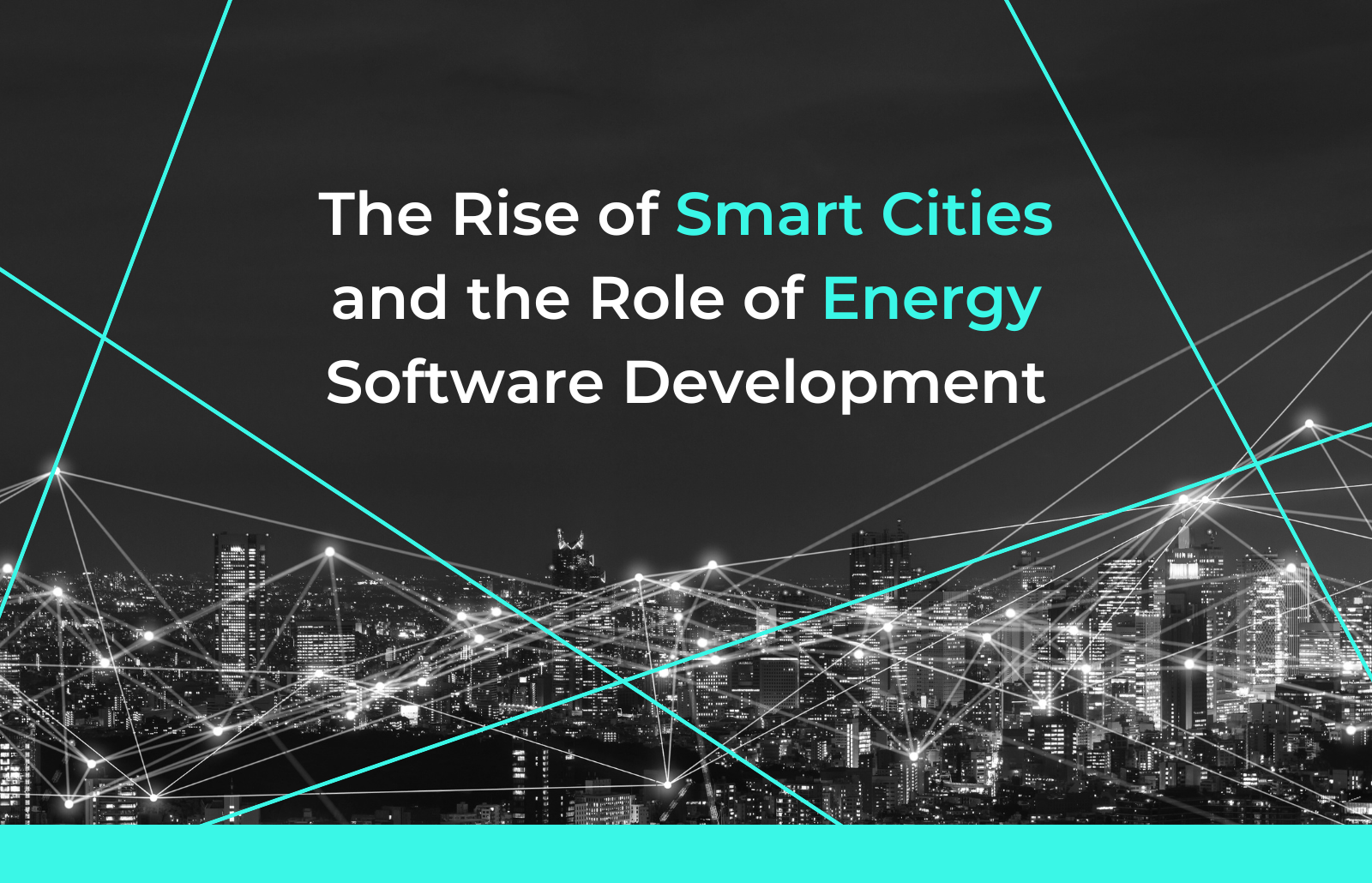The world we live in today is significantly different and even better than it was centuries ago. However, it hasn’t been without its challenges. With many people living in large cities and metropolises, environmental pollution is increasing, and it’s harming our planet. Thankfully, the creation of smart technology and eco-friendly energy sources is changing our story.
In this article, we’ll explore smart cities and the crucial role that software development plays in building them. You’ll also learn how energy software can help your organization manage energy efficiently.
Let’s get started!
What is a Smart City?
A smart city is an urban area that leverages eco-friendly information and communication technology to improve the quality of life for its citizens.
Smart cities rely on smart technology and data analysis to drive their functions while boosting economic growth. Another focus of smart cities is energy conservation because you can easily monitor and control environmental issues like pollution and climate change.
A smart city uses various intelligent technologies, such as the Internet of Things (IoT), machine learning (ML), and automation.
Which Software Solutions Connect Homes to Cities?
When we speak of cities, the first thing to realize is that a city only exists because it has individual homes within it. The same applies to smart cities — they comprise smart homes.
Smart homes usually have modern devices and systems that can be controlled remotely and with minimal effort. But how do these houses function or interact with each other and the city as a whole?
Well, software solutions are the brains behind this interdependence.
Let’s check out some of them below:
1. IoT
The Internet of Things is the backbone of how smart homes and cities interact. With real-time monitoring and communication, smart homes and cities can connect seamlessly and exchange data.
Here are different scenarios that capture how it works:
- Smart energy conservation: Smart plugs and other energy monitoring systems allow smart homes to get accurate data on their energy consumption. The houses can now share this information with smart power grids to ensure a more efficient energy distribution within the city.
- Security systems: With motion sensors and security cameras, homeowners can control their house security. Smart homes can then connect with the city’s security systems to help the government improve public security through prompt emergency response.
- Weather updates: The government can update its citizens with details like early storm warnings and data on other environmental factors.
2. Cloud-based Computing
The interconnection between smart homes and smart cities generates large amounts of data that must be stored and processed in a flexible, scalable and flexible environment. Cloud computing systems make such data management possible. They have unlimited virtual storage that can accommodate petabytes of data generated from smart devices across the city.
The dynamic and unpredictable data poured in from sensors, security cameras, smart thermostats, and lighting systems across smart homes can be easily managed to aid real-time decision-making and long-term analytics.
Furthermore, cloud-based computing uses strong encryption and authentication protocols to protect sensitive information collected across smart homes.
3. Artificial Intelligence (AI)
AI is vital in connecting smart homes to city infrastructure by enabling software solutions that optimize resource management and resident well-being. Here are some key applications:
AI in Energy Optimisation
AI algorithms can analyze real-time energy consumption data from smart home devices like thermostats and appliances. This data can be used for the following:
- Predict peak demand: By anticipating high-load times, AI can communicate with the city’s power grid to ensure sufficient energy availability and prevent outages.
- Dynamic pricing: AI can suggest real-time pricing models to homeowners based on grid demand, incentivizing them to shift energy usage to off-peak hours and reduce overall consumption.
- Automated adjustments: AI-powered smart home systems can automatically adjust thermostats, lighting, and other appliances to optimize energy use without compromising comfort.
- Waste Management Optimization: AI can analyze waste collection data from smart bins or connected sensors to determine the most efficient routes for garbage trucks. This reduces unnecessary travel, minimizes carbon emissions, and optimizes waste collection schedules.
AI in Personalised User Experience
AI can analyze user behavior patterns and preferences within smart homes and use the insights to:
- Suggest energy-saving measures: AI can identify areas where homeowners might be able to reduce energy consumption further.
- Proactive maintenance: AI can analyze sensor data to predict potential equipment failures within smart homes and alert homeowners or maintenance teams proactively.
Characteristics of Smart Cities
Smart cities proactively create services, address problems, and provide solutions because of their design. Check out the other characteristics of these digital metropolises.
- Sustainable energy: Smart cities use smart systems and devices to increase energy efficiency, reduce energy demands, and optimize sustainable energy sources to reduce carbon footprint. With technologies like sensors, smart grids, smart homes, and smart lighting, these cities can effectively produce, distribute, store, and manage energy.
Common examples of eco-friendly energy include hydropower, wind, solar, geothermal, and biomass.
- Data-riven insights: Smart cities incorporate technologies that help collect real-time data to function properly. Armed with such insight, the government can improve its services and strategies to fulfill its promises of a better quality of life for its citizens.
- Economic growth: Smart city technologies serve as a foundation for economic growth. As a result of innovation and better infrastructure, there is the creation of more job opportunities.
- Networking and connectivity: With sensors everywhere in the city, government officials can communicate directly with residents and monitor the city’s infrastructure more effectively.
- Open data: Smart city governments operate with an open data philosophy. As such, they regularly share data about their operations and planning with the public.
Smart Cities Technologies
Smart cities aim to boost their urban infrastructure, resources, and services to ensure sustainability while creating better lives for their citizens. Here are some technologies that have helped them accomplish these goals.
- Smart parking and transportation systems: Smart parking systems can monitor and update motorists about parking space availability with AI and IoT. Smart transportation also makes it easy to use electric vehicles and other autonomous vehicles to improve traffic flow and further reduce carbon footprints.
- Smart waste management systems: Smart waste bins, waste level sensors, and AI recycling robots make waste management cost-effective, efficient, and environmentally friendly.
For example, smart waste bins can help with recycling sorting, waste level sensors help collection officers predict when bins need to be emptied, and AI robots reduce the need for human workers.
- Smart traffic management systems: IoT, AI, and technologies like geolocation help the transportation agency collect real-time data to improve public transportation. This information can also help them curb issues like traffic congestion and carbon emissions, which improves their citizens’ quality of life.
- Smart lighting systems: Automation is critical in smart cities’ operations because it helps them perform many activities with little human control. Using automation, streetlights can detect motion and turn on or off based on the feedback they receive. Automatically turning off the streetlights when they are not needed ensures energy efficiency and sustainability.
- Smart grids for a sustainable future: Smart grids can utilize green resources more effectively. Unlike traditional grids that struggle with fluctuating renewable energy sources like solar and wind, smart grids leverage two-way communication and automation to seamlessly integrate these resources. This allows for predicting energy demand, optimizing consumption across the city, and ultimately reducing reliance on fossil fuels.
The Role of Energy Software Development in Smart Cities
The vision of a socially, environmentally, and economically viable city came to life by developing smart cities. No wonder the buzz around this tech infrastructure keeps increasing. Statistics show that global spending on smart city initiatives reached $189.5 billion in 2023. Energy-efficient software development is one of the core of an intelligent city’s design for the following reasons:
1. It Aids Data Management and Analysis
These solutions make it easy for smart cities to effectively collect, store, analyze, and manage energy-related data. With such insights, these digital cities can identify areas of improvement and make data-driven decisions. This eventually translates to optimum energy usage and overall energy efficiency.
2. It Ensures Energy Compliance
Energy software development ensures regulatory compliance in smart cities by providing services like energy risk management, power plant operation and maintenance, and emissions monitoring. This function helps mitigate risk and ensure operational efficiency.
3. It Improves Reliability and Cost-effectiveness
Energy software solutions help smart cities identify downtime and potential issues beforehand through predictive analysis and real-time data collection. This allows the government to increase reliability and reduce operational costs while extending the life of its smart infrastructure.
4. It Boosts Service Delivery and Efficiency
Energy software development solutions help smart cities understand their shortcomings and suggest processes and systems that ensure efficient service delivery.
5. It Maximizes Energy Output
Renewable energy software development technologies help smart cities cater to the diverse energy needs of the metropolis. Through resource assessment and grid integration, the government can improve grid stability and optimize the output of sustainable energy sources.
6. It Ensures Better Customer Services
When it comes to smart cities, the customers to be served are the citizens. Energy software solutions allow digital towns to meet and adapt to their residents’ dynamic demands. They also ensure optimal energy usage while serving the citizens’ preferences.
Smart Energy Software Solutions Made For You!
We have no other home than our universe, and we are responsible for keeping it safe while making life easy for ourselves. Energy software companies like Zartis understand the needs of smart cities and are doing an excellent job of ensuring energy efficiency without compromising on the residents’ comfort.
We are committed to providing custom software development solutions for smart cities worldwide. Our scalable and sustainable solutions are secure, modern, and future-ready.
Whether you need one engineer or a full and dedicated development team for your smart project, we’ve got you covered.
Moreover, if time is not on your side and you need to get things done more quickly, our senior engineers are always ready to save the day!





